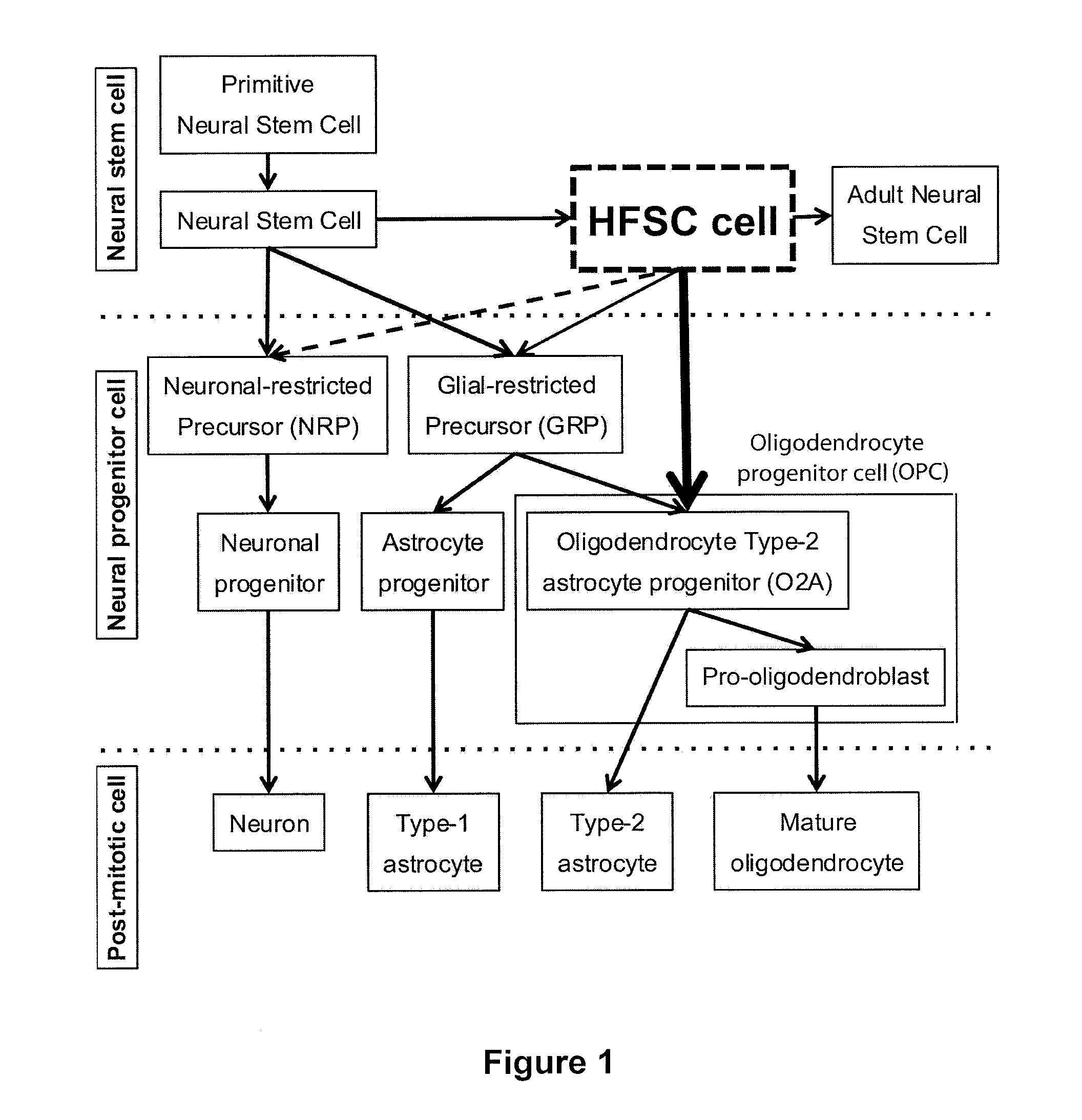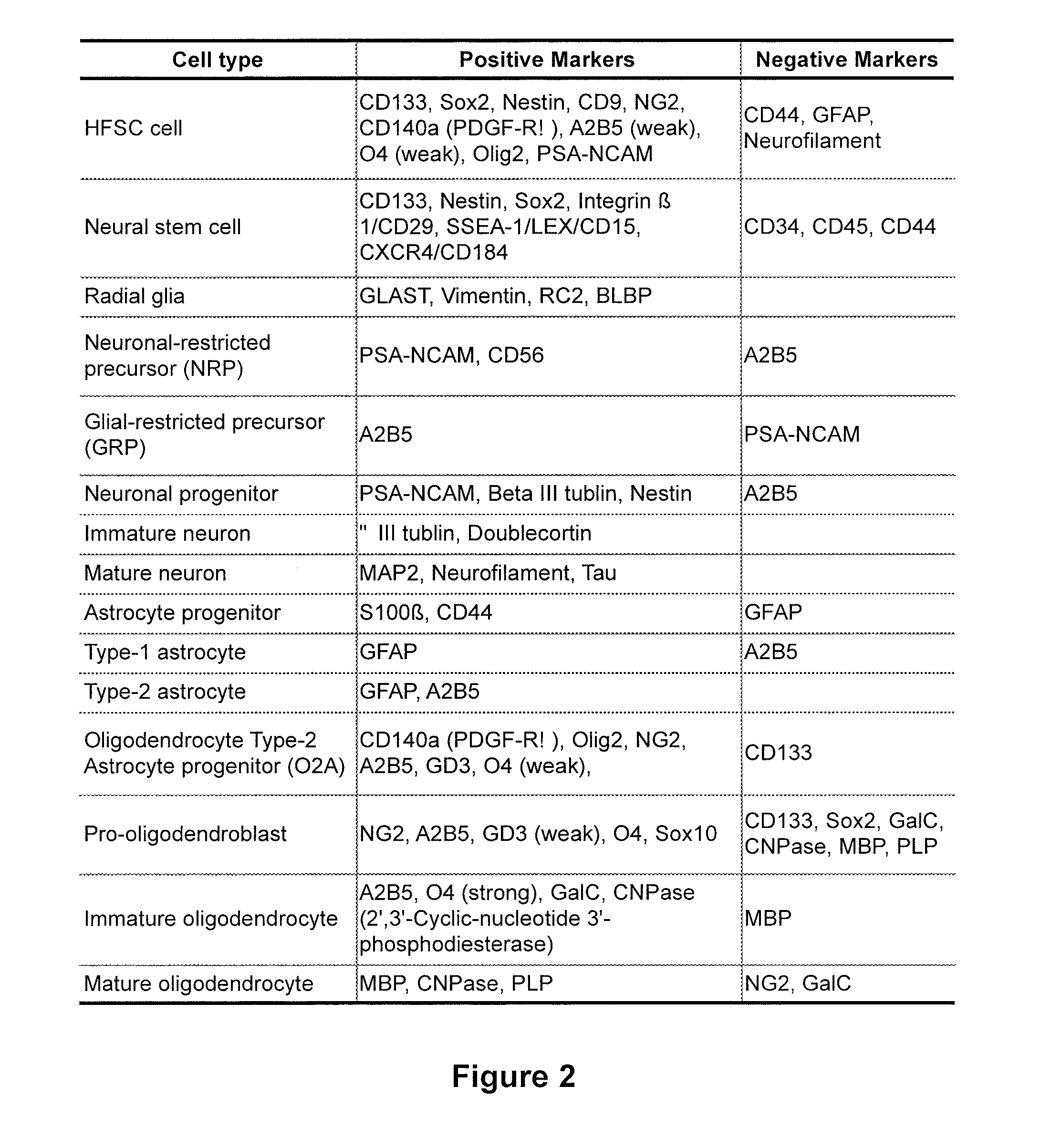Culture method to obtain and maintain a pure or enriched population of mammalian neural stem cells and/or neural/progenitor cells that are prone to differentiate into oligodendrocyte-lineage cells in vitro
a technology of neural stem cells and oligodendrocytes, which is applied in the field of cell biology of mammalian neural stem cells and/or neural progenitor cells, can solve the problems of affecting the use of oligodendrocytes in research or human therapy, unable to obtain oligodendrocytes directly from tissue samples in sufficient quantities for human use, and unable to proliferate mature oligodendrocytes. proliferation and other a cell biology of neural stem cells and cell biology of neural stem cells and cell biology of neural stem cells and cell biology of neural stem cells and cell culture method of mammalian neural stem cells and cell biology of neural stem cells and cell culture method, which is applied in the field of mammalian neural stem cells and a technology of neural progenitor cells, which is applied in the field of cell biology which is applied in the field of cell biology of neural progenitor cells and cell-cell interactions a technology of neural stem cells and a technology of mammalian neural stem cells and a technology of neural stem cells and a technology of mammalian neural stem cells and a technology of mammalian neural stem cells and oligodendrocyte-lineage cells, which is applied in
- Summary
- Abstract
- Description
- Claims
- Application Information
AI Technical Summary
Benefits of technology
Problems solved by technology
Method used
Image
Examples
example 1
HFSC Cell Culture and Expansion; Identification of Base Medium and Growth Factors
[0103]Several medium and supplements were tested in a preliminary experiment using HFSC cells derived from human 12-week fetal spinal cord, which was obtained from Advanced Bioscience Resources, Inc. (Alamada, Calif., USA) with an informed consent of a donor. The cells were cultured in DMEM:F-12 (1:1) (DMEM / F12) (Invitrogen™, Carlsbad, Calif., USA) supplemented with 2 mM glutamine (Invitrogen™), 1 mM pyruvate (Invitrogen™) and 2% B27 supplement (Invitrogen™) initially. Various growth factors were examined whether they stimulate growth of HFSC cells. Most effective growth factors were the combination of PDGF-AA and bFGF. The cells could grow in the presence of PDGF-AA and bFGF but showed vacuoles and looked unhealthy. Several supplements were tested and it was observed that DMEM / F12 supplemented with 1% NEAA in addition to 2 mM glutamine, 1 mM pyruvate and 2% B27 supplement could decrease vacuoles and in...
example 2
Identification of Optimal Growth Condition for HSCF Cell Expansion
[0105]As mentioned in Example 1, inclusion of PDGF-AA and bFGF in the culture medium supported adequate growth of the HFSC cells initially, but the proliferation rate slowed after 2 passages. NT-3 (R&D Systems) and IGF-1 (Sigma-Aldrich™) were tested to determine if they could enhance the proliferation of HFSC cells. The presence of 20 ng / ml PDGF-AA with 10 ng / ml bFGF was insufficient to stimulate the proliferation rate of the cells (the expansion rate was 1). Combination of NT-3 and IGF-1 was most effective at passage 3. The cells obtained from each condition were further passaged to confirm their effects. The cells were harvested earlier because the cells started forming spheres. At passage 4, the recovery of proliferation rate by combination of NT-3 and IGF-1 was decreased and single addition of IGF-1 became most effective at passage 4. Combination of NT-3 and IGF-1 might cause differentiation of cells or form more ...
example 3
Spontaneous Differentiation Technique of HSCF Cell
[0109]While testing various culture conditions, it was observed that when HFSC cells were cultured with the removal of bFGF from the medium, many of the cells seemed to differentiate into bipolar or multipolar cells (indicative of oligodendrocyte) and died soon. To avoid these cell death, a spontaneous differentiation technique was developed.
[0110]Culture medium was usually changed every 2 days for expanding HFSC cells and it was thought to be very important to keep HFSC cells in proliferative state. To enhance cell differentiation, medium was changed every 3 or 4 days for this experiment. Basic FGF and high concentration of PDGF-AA were thought to block differentiation of HFSC cells but they were also important for HFSC cells to survive. Therefore, PDGF-AA concentration was decreased from 100 to 20 ng / ml in the presence of 10 ng / ml bFGF, 10 ng / ml IGF-1 with 50 μM 1-thioglycerol or without 1-thioglycerol. HFSC cells couldn't survive ...
PUM
| Property | Measurement | Unit |
|---|---|---|
| concentration | aaaaa | aaaaa |
| concentration | aaaaa | aaaaa |
| concentration | aaaaa | aaaaa |
Abstract
Description
Claims
Application Information
 Login to View More
Login to View More - R&D
- Intellectual Property
- Life Sciences
- Materials
- Tech Scout
- Unparalleled Data Quality
- Higher Quality Content
- 60% Fewer Hallucinations
Browse by: Latest US Patents, China's latest patents, Technical Efficacy Thesaurus, Application Domain, Technology Topic, Popular Technical Reports.
© 2025 PatSnap. All rights reserved.Legal|Privacy policy|Modern Slavery Act Transparency Statement|Sitemap|About US| Contact US: help@patsnap.com



